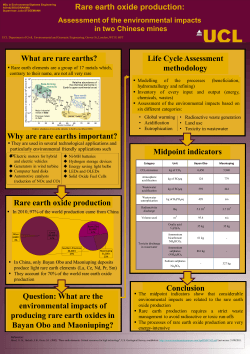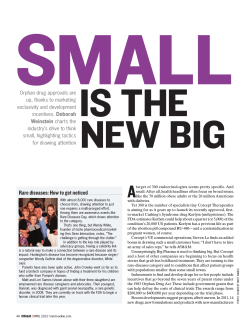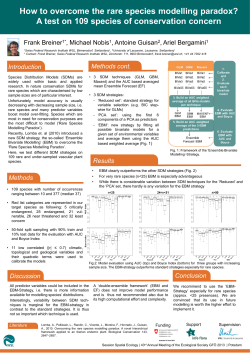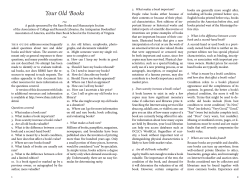
Document 276132
Beacon Rock Research, LLC December 2, 2013 B EACON R OCK R ESEARCH 1 D E C E M B E R 2, 2013 R ESEARCH N OTE N AMIBIA R ARE E ARTHS I NC . (TSX: NRE, C$0.11 www.beaconrockresearch.com Disclosures 1, 2, 3 PER SHARE) 5956 N.W. 213th, Portland, Oregon 97229 Mike Niehuser, 503-307-3188 mike@beaconrockresearch.com Namibia Rare Earths Successfully Advances Metallurgy of Rare Earth Deposit Namibia Rare Earths (TSX: NRE, OTCQX: NMREF) reported on the completion of five more metallurgical drill holes at Lofdal to provide larger volumes of material for metallurgical test work, and provided an update on the ongoing metallurgical test work in South Africa and Australia. This should increase options to determine a flow sheet for producing a concentrate acceptable to a qualified joint venture partner. The additional five HQ drill holes for metallurgical test work reinforced the deposit’s geologic model for grade, geometry, and high level of heavy rare earth enrichment (HREE), and provided over 2,000 kg of representative grade material to support the metallurgical test work. Since the completion of the resource estimate, for the most part, resource expansion and exploration has taken a back seat to the metallurgical test work to complete a flow sheet to produce a heavy rare earth concentrate. Namibia Rare Earths previously completed two HQ drill “scissor holes” through the deposit for metallurgical purposes. These two samples somewhat bracketed the resource, confirming the consistency of the deposit and validating the geologic model. These first two holes were selected to secure both a high grade (NLOFDH4084 at 1.50% TREO with 94.7% HREE) and low grade (NLOFDH4085 at 0.26% TREO and 80.8% HREE) sample to better understand and optimize a flow sheet for a range of both high and lower grade portions of the resource. Drill Rig at Area 4, Completing Scissor Hole - Hole NLOFDH4085, taken for Metallurgical Purposes) Source: Analyst _______________________________________________________________________________________________________________________________________________________________________________ This information is obtained from sources believed to be reliable, but its accuracy and completeness are not guaranteed. Copying, faxing, replicating, or quoting from this report without permission is in direct violation of copyright laws. Beacon Rock Research employees and affiliates may have positions and effect transactions in the securities or options of the issuers reported herein. Please refer to the company index in the back of this issue for additional disclosures. Beacon Rock Research, LLC 2 December 2, 2013 Initially, results from test work on the high grade sample following optimization were to be applied to the lower grade sample with the intent to boost recoveries of the resource at the margin. This approach was expected to both de-risk and improve the economics of the resource, potentially increasing the size of the resource (by reducing the cut-off grade) and improve the grade of the concentrate. These activities fit within the corporate objective of defining the quality of the resource and in determining the best flow sheet for beneficiation, which is essential to increasing its attractiveness and value to a potential qualified technical partner. The release provides an update on the metallurgical test work results on both the initial high and low grade samples, and also on the significant improvements to recoveries to be expected from the upcoming bulk sample runs as a result of detailed calibration tests on the x-ray transmission (“XRT”) sorting technology. The XRT sorting was previously proposed as a means to improve beneficiation by initially removing waste and thereby increasing grade to the mill. A number of approaches are being considered for a range of flow sheets options to produce a concentrate including magnetic separation, a simple acid leach and flotation. These approaches would be applied to both the high and low grade samples to develop options for an initial flow sheet to produce a concentrate that would then be refined and optimized with further analysis made possible using material from the more recent HQ drill holes. The test work is being completed by Mintek in South Africa, and interestingly on the low grade sample, Nambia Rare Earths reported work completed by Nagrom laboratories from Australia. This is significant because Nagrom has experience in processing material from Northern Minerals Limited (ASX: NTU) Brown Range (Wolverine deposit), which is most similar to Namibia Rare Earths’ deposit at Area 4 at Lofdal in Namibia. Both deposits are highly enriched with heavy rare earths contained in xenotime. This should provide additional expertise to the initial metallurgical test work which will be applied to the material from the additional five HQ drill holes. Summary of Additional Drill Results for Metallurgical Purposes The additional five HQ drill holes totaled 708 meters over a 330 meter strike length in the center of the resource estimate. Of the five holes, two effectively twinned the initial “scissor holes,” with the remaining three holes basically closing the gap. Like the initial scissor holes, the five holes were completed at a shallow angle entering the mineralized zone underneath from the footwall, proceeding downdip through the deposit, and exiting into the hanging wall. This produced approximately 2200 kg (roughly 2.5 tons) of additional mineralized material, now available for further metallurgical test work. _______________________________________________________________________________________________________________________________________________________________________________ This information is obtained from sources believed to be reliable, but its accuracy and completeness are not guaranteed. Copying, faxing, replicating, or quoting from this report without permission is in direct violation of copyright laws. Beacon Rock Research employees and affiliates may have positions and effect transactions in the securities or options of the issuers reported herein. Please refer to the company index in the back of this issue for additional disclosures. Beacon Rock Research, LLC 3 December 2, 2013 Management indicates that drilling on the five HQ drill holes intersected and exited the mineralized zone as predicted. This provides further confidence that Namibia Rare Earths has completed a good geologic model, which should provide optimism for predicting a continuation of the deposit at depth beyond that included in the resource, and demonstrates the consistency of the tabular nature of the mineralized zone. It is also interesting to note that the grades and the level of heavy rare earth enrichment generally reflect that of the initial resource estimate. (As the drill hole was completed for metallurgical purposes, the mineralized interval is clearly not to be considered the true width of the deposit). Area 4 Drilling including metallurgical “scissor holes” in 2012 plus additional five holes for metallurgical purposes in 2013. Source: Namibia Rare Earths The initial resource, at a 0.3% cut-off, identified a 900,000 tonne Indicated resource of 0.62% TREO with 86% heavy rare earth enrichment and an Inferred resource of 750,000 tonnes at 0.56% TREO with 85% heavy rare earth enrichment. At a lower grade cut-off of 0.1%, the resource increases to an Indicated resource 2.88 million tonnes at 0.32% TREO with 76% heavy enrichment, plus the Inferred resource increases to 3.28 million tonnes at 0.27% TREO with 75% heavy enrichment. Summary of drill holes taken for metallurgical purposes. Source: Namibia Rare Earths _______________________________________________________________________________________________________________________________________________________________________________ This information is obtained from sources believed to be reliable, but its accuracy and completeness are not guaranteed. Copying, faxing, replicating, or quoting from this report without permission is in direct violation of copyright laws. Beacon Rock Research employees and affiliates may have positions and effect transactions in the securities or options of the issuers reported herein. Please refer to the company index in the back of this issue for additional disclosures. Beacon Rock Research, LLC 4 December 2, 2013 Improvements to Beneficiation by XRT Technology Tomra Sorting Solutions GmbH of Germany completed test work in 2012 and 2013 to determine the potential to presort run-of-mine material to selectively separate waste using XRT technology. Initial results reported in April of 2013 on the material from the initial two “scissor holes,” were positive, indicating 48 to 79% recovery with mass pulls of 55 to 75% to waste. This presented the opportunity for reducing costs by eliminating waste on site, thereby reducing the cut-off grade and increasing the amount of material to be economically recovered. Following this success, Tomra recommended a larger sample be obtained for additional test sorting, which resulted in the five new HQ drill holes. Commodas Ultrasort technician in Germany and sorting equipment, typical of what could be deployed to reduce waste and upgrade run of mine ore on site for shipping Source: Namibia Rare Earths Namibia Rare Earths believed that the sorting efficiency (recoveries) could be improved with detailed calibration tests assisted by estimating the percentage of total rare earth oxides (TREO) based on ppm yttrium as determined by handheld XRF devices. The detailed calibration of the sorting equipment increased recoveries to 85 to 89% with a mass pull averaging 47% to waste. This is a significant improvement to the first stage beneficiation, thereby improving the economics by eliminating waste rock early in the process without losing too much mineralized material. It is expected that completing sorting test work on the additional material from the five subsequent HQ drill holes will be completed by Tomra in early December. Following this test work, the sorted material will be available for Mintek and Nagrom to undergo additional test work for other various approaches to produce a concentrate. Discussion of Options for Concentrate Flow Chart Metallurgical test work to date has been limited to producing concentrates from the two initial “scissor holes.” In April of 2013, Namibia Rare Earths provided initial test results on the high grade sample drill results with recovery by wet high intensity magnetic separators (WHIMS), which only demonstrated the potential for magnetic separation to produce a concentrate. This produced good recoveries from Whole Ore and unsorted Fines under 10mm, improving for Sorted Product over 10mm of 77.9%. _______________________________________________________________________________________________________________________________________________________________________________ This information is obtained from sources believed to be reliable, but its accuracy and completeness are not guaranteed. Copying, faxing, replicating, or quoting from this report without permission is in direct violation of copyright laws. Beacon Rock Research employees and affiliates may have positions and effect transactions in the securities or options of the issuers reported herein. Please refer to the company index in the back of this issue for additional disclosures. Beacon Rock Research, LLC 5 December 2, 2013 Mintek—WHIMS Grades and Recoveries from Lofdal High Grade Sample (NLOFDH4084) - April 2013 Source: Namibia Rare Earths The recent release included the same WHIMS process with the introduction of scavenging and regrind circuits which increased recoveries for Sorted Product over 10mm to 89.5% and the concentrate grade increased to about 11.1% from about 10.2% with WHIMS alone. Namibia Rare Earths believes that a concentrate grade of 10% can be of interest to a qualified joint venture partner, so it would seem significant that as outlined in the current press release the addition of a simple acid leach to Sorted Product magnetic concentrate has nearly doubled the concentrate grade to 19.8%, representing a recovery of 99% from the WHIMS product. Mintek—WHIMS Grades and Recoveries After Scavenging from Lofdal High Grade Sample (NLOFDH4084) - November 2013 Source: Namibia Rare Earths Mintek—WHIMS Grades and Recoveries Before Scavenging and After Leaching from Lofdal High Grade Sample (NLOFDH4084) - November 2013 Source: Namibia Rare Earths The lower grade sample responded well to recovering xenotime, but the higher amounts of gangue mineralization including albite, calcite and hematite, and the fact that the lower grade sample is more oxidized than the higher grade sample present challenges on recoveries. For example, WHIMs with a regrind and scavenging circuit produced a concentrate from Sorted Product over 10mm with a grade of 1.65% and a recovery of 55.1%. These first reported test results on the low grade material represent the baseline and it will be interesting to see how the optimization of the WHIMS and addition of an acid leach might reduce gangue minerals, or how other methods improve concentrate grade and recoveries. _______________________________________________________________________________________________________________________________________________________________________________ This information is obtained from sources believed to be reliable, but its accuracy and completeness are not guaranteed. Copying, faxing, replicating, or quoting from this report without permission is in direct violation of copyright laws. Beacon Rock Research employees and affiliates may have positions and effect transactions in the securities or options of the issuers reported herein. Please refer to the company index in the back of this issue for additional disclosures. Beacon Rock Research, LLC 6 December 2, 2013 Nagrom produced a concentrate from the same low grade material by floating WHIMS product, producing similar grades but much better recoveries for Whole Ore and Sorted Product over 10mm. This is interesting as one might expect the necessity for the flotation process with oxidized material. It is also interesting that different approaches may have significantly different results based on variances of grade, degree of oxidation and the gangue mineralogy. Additional metallurgical test work will eventually lead to a flow sheet, and will take these variances into account in the most economic manner. Clearly, the results from the initial two “scissor holes” were early in the process and this update has demonstrated significant progress and understanding on the metallurgical characteristics of the deposit. The large amount of material now available for test work should accelerate optimizing the flow sheet. Analyst Visit to Namibia Rare Earths’ Lofdal Project in Namibia We toured Namibia in September of 2013 with the Oregon Society of Economic Geologist Student Chapter, visiting past and working mines, exploration projects and various geologic occurrences. Namibia Rare Earths’ Lofdal project was included in the tour. Having previously visited Lofdal, we were most interested in observing trends in the government and people of Namibia toward mining, foreigners and foreign investment, as well as to note any trends in Namibia toward mining in general. The visit enhanced our opinion of the relative high importance of mining to Namibia from the perspective of taxation and employment. Recognizing the increasing number of years to bring a deposit to an active mine, we were alarmed that all of the active mines visited on the tour appeared nearing the end of the initial mine life and were stretching to push back open pits or advancing lower grade and less optimal tertiary deposits. This should increase the importance to the government of advancing projects to construction and production, as well as to commit to a predictable taxation regime to attract foreign capital. Solvay SA Okorusu Fluorspar mine in NE Namibia Source: Analyst _______________________________________________________________________________________________________________________________________________________________________________ This information is obtained from sources believed to be reliable, but its accuracy and completeness are not guaranteed. Copying, faxing, replicating, or quoting from this report without permission is in direct violation of copyright laws. Beacon Rock Research employees and affiliates may have positions and effect transactions in the securities or options of the issuers reported herein. Please refer to the company index in the back of this issue for additional disclosures. Beacon Rock Research, LLC 7 December 2, 2013 We were fortunate to have been guided by Dr. Roy Miller, who is considered to be the “godfather” of Namibian Geology. His frankness was helpful to make systematic inquires as well as place observations in context. We were concerned about rule of law and Namibia’s part in a global progressive trend toward active government overreach. It was interesting that while we were in Namibia, the courts upheld the assertion of farmers and threw out what they viewed were excessive and potentially bankrupting tax increases on marginally productive land. Also important were the independent critical opinions expressed in the press toward government tax assessors following this landmark reprimand by the courts. This provided a refreshing view of both impartial courts and independent press. Both of these, in our experience and opinion, are important for rule of law important to foreign investment. We assume this type of treatment would be extended to the mining industry as well. Trenching at Lofdal Area 4 , Note Visitors Pointing at Carbonatite Dike Near Surface Source: Analyst We were also quite interested in the attitude of people or government toward investment from China. There appeared to be a distinct opinion, generally from a wide range of individuals, to the Chinese manner of doing business of cutting corners or being less sensitive to building requirements, including Namibian workers or local contractors. This was particularly important considering the largest project now under construction is the Husab uranium mine. It will be important for Namibia to fully support and enable regulators to enforce regulations. It is interesting that while companies from “developed nations” may lack the national financial clout of China, they are well versed in the important commitment toward community engagement and partnerships. This is a distinct advantage for “developed nations” should it be a priority for the Namibian government. Comments on the Rare Earth Sector of the Mining Industry The prices of mining companies, including companies in the rare earth niche, and the prices of both light and rare earths appear to have bottomed. Our investment thesis anticipated that this trend may allow for the destruction of the field of weaker companies and projects. This would include projects with not only a poor collection of attributes important to successfully develop a mine, but in the case with rare earth deposits, this would further include predominately light rare earth deposits or deposits with a patchwork of mineralization challenges. It would also appear that mining companies with excessive requirements for infrastructure or costly processing may have high financing requirements which are particularly unattractive to investors. _______________________________________________________________________________________________________________________________________________________________________________ This information is obtained from sources believed to be reliable, but its accuracy and completeness are not guaranteed. Copying, faxing, replicating, or quoting from this report without permission is in direct violation of copyright laws. Beacon Rock Research employees and affiliates may have positions and effect transactions in the securities or options of the issuers reported herein. Please refer to the company index in the back of this issue for additional disclosures. Beacon Rock Research, LLC 8 December 2, 2013 It is also interesting to us that investors have no tolerance for assumptions in technical reports which appear not to have been thoroughly vetted. While important for all types of mining projects, given the heightened metallurgical requirements to cost effectively produce a rare earth concentrate, a consistent and thorough metallurgical program remains an indispensible component of developing rare earth projects. Consequently, a complete and credible metallurgical program is essential to monetize the resource to both the investment community and to secure a qualified joint venture partner. In our opinion, companies with the most attractive projects to develop are located in mining jurisdictions friendly to mining with good infrastructure and modest capital costs to reduce financing risk. High concentration of heavy rare earths is essential, at grades or with the potential to concentrate and improve economics. Clearly, metallurgy is important. We see Namibia Rare Earths’ Lofdal project and Northern Minerals Limited Wolverine deposit having the greatest potential given their level of heavy rare earths and important to their being contained in xenotime with an existing commercially proven pathway to production. Tasman Metals Ltd. (NYSE MKT: TAS) and Matamec Explorations, Inc. (TSX – V: MAT) also have heavies but are contained within eudyalite and have successfully graduated from the lab to a critical pilot plant stage. Ucore Rare Metals Inc. TSX – V: UCU) also has a promising solid phase extraction in the lab, but this also has not been proven commercially. Should unproven technologies fail to advance as scheduled, it is apparent that the projects in xenotime mineralization have the greatest potential to outpace competitors. In addition, depending on the unfolding information on heavies in China, it will be interesting to see the impact on heavy rare earth prices, with few projects in the rest of the world moving into production as scheduled. Concluding Comments We continue to believe that ongoing demand for heavy rare earths, with limitations on production and the addition of the containment of illegal mining in China, should lead to higher prices for heavy rare earths. It is apparent by most any forecast that increases in supply are suspect to meet demands for heavy rare earths outside China (and in the case of dysprosium, within China itself). In our opinion, of the hundreds of rare earth projects, Namibia Rare Earths’ Lofdal project remains one of only a handful of potential projects capable of success. The recent metallurgical results provide great transparency for investors as to the numbers of considerations and the importance of a consistent and well understood deposit. One of the most important issues with failures inherent in feasibility studies, is the inability to move from lab to the mill and produce product as predicted. The results demonstrate multiple options for robust recovery, as seen in work completed on the higher grade sample. It also demonstrates the challenges of improving the economics of lower grade portions of the deposit. In the case of the low grade sample, included are not only lower grades, but it is also complicated by higher levels of oxidation and the inclusion of gangue mineralization. Management should be complimented for the foresight to include the lower grade sample early in the process and its transparency in reporting results. Clearly, this will remain an area of focus, as much as extending progress for the high grade sample, to better understand the deposit in completion of a reliable flow chart. _______________________________________________________________________________________________________________________________________________________________________________ This information is obtained from sources believed to be reliable, but its accuracy and completeness are not guaranteed. Copying, faxing, replicating, or quoting from this report without permission is in direct violation of copyright laws. Beacon Rock Research employees and affiliates may have positions and effect transactions in the securities or options of the issuers reported herein. Please refer to the company index in the back of this issue for additional disclosures. Beacon Rock Research, LLC 9 December 2, 2013 Namibia Rare Earths is in an excellent position to build upon metallurgical test work to date. Work continues on the material secured from the initial “scissor holes.” Having provided an additional 2,200 kg’s to the labs for additional test work should provide a significant opportunity to increase the value of the resource at relatively little cost. Management should also be complimented for securing a large sample to the labs, which exceptionally enhances the opportunity for the labs to produce data that may optimize the resource. As there is proven technology to recover heavy rare earths from xenotime, there is less risk and possibly time to production than competing projects requiring new processes. While there is clearly potential to expand the resource by additional drilling at depth, following through on metallurgical test work is the most direct path to both attract a qualified joint venture partner and monetize Area 4 of Lofdal. Namibia Rare Earth Geologist Boniface Katanga with Analyst at Main Intrusion Niobium-Uranium Target at Lofdal Source: Analyst Namibia Rare Earths has 77.8 million shares outstanding and 83.0 million shares fully diluted. Options and warrants have an exercise price ranging from $0.41 to $0.80 per share. Presently, Namibia Rare Earths has a market cap of about $9.3 million. As of August 31, 2013, Namibia Rare Earths had cash and cash equivalents of about $11.8 million (about $0.15 per outstanding shares) and negligible debt. The company appears to have adequate financial liquidity to complete development activities through 2014. Major Shareholders include Oberndorf Enterprises (30.5%), Bill Price (11.6%) and Adrian Hickey (8.0%). _______________________________________________________________________________________________________________________________________________________________________________ This information is obtained from sources believed to be reliable, but its accuracy and completeness are not guaranteed. Copying, faxing, replicating, or quoting from this report without permission is in direct violation of copyright laws. Beacon Rock Research employees and affiliates may have positions and effect transactions in the securities or options of the issuers reported herein. Please refer to the company index in the back of this issue for additional disclosures. Beacon Rock Research, LLC 10 December 2, 2013 DISCLOSURES: Beacon Rock Research, LLC provides information and analysis on selected companies, with a focus on small-cap and micro-cap companies. This report has been written in accordance with current SEC regulations and the Standards of Practice developed by the Chartered Financial Analyst Institute (CFAI). Our research has been conducted by employing analytical practices generally accepted as standard within the analytical industry. In this instance, a comparison of financial strength, a bottom-up earnings projection based on a recovery in the U.S. economy, and relative multiples, were employed. Target prices are calculated on comparative EPS, sales and book value multiples, and our knowledge of small-cap markets when enjoying both a sector and a cyclical rebound. Our conclusions are, by the very nature of forecasting, speculative, but are also reasonable, supportable and consistent. Key to disclosures: 1. 2. 3. The Subject Company is paying an fee of $4,000 per month to SLB Equity Research, LLC., one of its affiliates, for research coverage, institutional introductions, and other awareness building services. The research analyst owns shares of common stock in the Subject Company. This report was prepared exclusively for the benefit of institutional investors and may or may not receive compensation directly or in soft dollar arrangements. The analyst, Mike Niehuser, hereby certifies that the research conclusions and recommendation contained herein accurately reflects his personal views about the industry, company and shares and also hereby certifies that no part of his research compensation was or will be directly or indirectly related to the earnings estimates, target price or recommendation about the security. The research provided herein should not be considered a complete analysis of every material fact regarding the companies, industries or securities named above. The opinions expressed herein reflect the analysis and judgment of the author on the date of publication and are subject to change without notice. Facts have been obtained from sources considered reliable but should not be construed as complete and are not guaranteed to be accurate. Beacon Rock Research, LLC; its members; employees and their families may have positions in the securities covered within the research material above and may make purchases or sales while this report is in circulation. Additional information on the subject companies is available upon request. EQUITY RECOMMENDATION SYSTEM: Strong Buy Immediate purchase is recommended. The security is expected to outperform the market over the next six to 12 months. Buy Immediate purchase is recommended. The security is expected to outperform the market over the next 12 to 18 months. Hold Holding the stock is recommended because the share price’s appreciation potential is less than or equal to the market. Sell The stock has reached the target price objective and/or conditions have changed sufficiently to alter the outlook for the stock. EQUITY RISK SYSTEM: High The security is more volatile than the market and/or the company is more leveraged than its peer group. Moderate The security has about the same volatility as the market and/or the company carries a level of leverage in line with its peer group. Low The security is less volatile than the market and/or the company is less leveraged than its peer group. DISTRIBUTION OF RECOMMENDATIONS: At this time, there are an insufficient number of companies under coverage to generate usable distribution information or draw any conclusions regarding bias about the research methodology. Prospective companies are screened and evaluated by sales personal and research analysts with the investment thesis and overall research recommendation developed before the commission is established. _______________________________________________________________________________________________________________________________________________________________________________ This information is obtained from sources believed to be reliable, but its accuracy and completeness are not guaranteed. Copying, faxing, replicating, or quoting from this report without permission is in direct violation of copyright laws. Beacon Rock Research employees and affiliates may have positions and effect transactions in the securities or options of the issuers reported herein. Please refer to the company index in the back of this issue for additional disclosures.
© Copyright 2025









